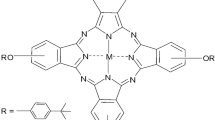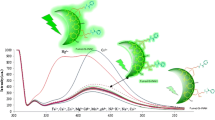Abstract
We have synthesized novel sulfonamide-based nano-composite (SAN) for selective and sensitive detection of Fe3+ ions in aqueous samples. Morphological characterization of SAN was carried out with TGA, FT-IR, UV–Vis, ninhydrin assay, FE-SEM, pXRD, BET, EDX, and elemental analysis. The sensing nature, effect of pH, sensor concentration and response time analysis were accomplished with the help of emission spectral studies and SAN was assessed as “turn-on” emission detector for the biologically important Fe3+ ions. Here, the LOD and LOQ were computed to be 26.68 nM and 88.93 nM, respectively, and it was found to be much lower than the permissible limit of Fe3+ ions in drinking water. The accuracy of the sensor (SAN) was determined by testing the aqueous samples spiked with known concentrations of Fe3+ ions and results demonstrated 98.00–99.66% recovery, which made SAN a reliable, selective and sensitive chemosensor for the quantification of Fe3+ ions in fully aqueous media.
Graphical abstract


















Similar content being viewed by others
Data availability
All data generated or analyzed are included.
References
Bhuvanesh, N., Velmurugam, K., Suresh, S., Prakash, P., John, N., Murugan, S., Daniel Thangadurai, T., & Nandhakumar, R. (2017). Naphthalene based fluorescent chemosensor for Fe2+-ion detection in microbes and real water samples. Journal of Luminescence, 188, 217–222. https://doi.org/10.1016/j.jlumin.2017.04.026
Gregory, P. J., Wahbi, A., Adu-Gyamfi, J., Heiling, M., Gruber, R., Joy, E. J. M., & Broadly, M. R. (2017). Approaches to reduce zinc and iron deficits in food systems. Global Food Security, 15, 1–10. https://doi.org/10.31220/agriRxiv.2021.00033
Sivaraman, G., Sathiyaraja, V., & Chellappa, D. (2014). Turn-on fluorogenic and chromogenic detection of Fe(III) and its application in living cell imaging. Journal of Luminescence, 145, 480–485. https://doi.org/10.1039/C3RA45931D
Camaschella, C. (2017). New insights into iron deficiency and iron deficiency anemia. Blood Reviews, 31, 225–233. https://doi.org/10.1016/j.blre.2017.02.004. Epub 2017 Feb 13.
Goswami, S., Aich, K., Das, A. K., Manna, A., & Das, S. (2013). A naphthalimide–quinoline based probe for selective, fluorescence ratiometric sensing of trivalent ions. RSC Advances, 3, 2412–2416. https://doi.org/10.1039/C2RA22624C
Burdo, J. R., & Connor, J. R. (2003). Brain iron uptake and homeostatic mechanisms: An overview. BioMetals, 16, 63. https://doi.org/10.1016/S0306-4522(03)00590-6
Bonda, D. J., Lee, H., Blair, J. A., Zhu, X., Perrya, G., & Smith, M. A. (2011). Role of metal dyshomeostasis in Alzheimer’s disease. Metallomics, 3, 267. https://doi.org/10.1039/c0mt00074d
Pithadia, A. S., & Lee, M. H. (2012). Metal-associated amyloid-β species in Alzheimer’s disease. Current Opinion in Chemical Biology, 16, 67. https://doi.org/10.1023/a:1020718718550
Sen, S., Sarkar, S., Chattopadhyay, B., Moirangthem, A., Basu, A., Dharad, K., & Chattopadhyay, P. (2012). A ratiometric fluorescent chemosensor for iron: Discrimination of Fe2+ and Fe3+ and living cell application. The Analyst, 137, 3335–3342. https://doi.org/10.1039/C2AN35258C
Shah, N., Ain, F., Ahmed, I., Anis, I., & Shah, M. R. (2017). A new highly selective chemosensor for the detection of iron ion in aqueous medium based on click generated triazole. Sensors and Actuators, B: Chemical, 249, 515–522. https://doi.org/10.1016/j.snb.2016.08.025
Şenol, A. M., Onganer, Y., & Meral, K. (2017). An unusual “off-on” fluorescence sensor for iron (III) detection based on fluorescein–reduced graphene oxide functionalized with polyethyleneimine. Sensors and Actuators B: Chemical, 239, 343–351. https://doi.org/10.1016/j.snb.2016.08.025
Mameli, M., Aragoni, M. C., Arca, M., Caltagirone, C., Demartin, F., Farruggia, G., De Filippo, G., Devillanova, F. A., Garau, A., Isaia, F., Lippolis, V., Murgia, S., Prodi, L., Pintus, A., & Zaccheroni, N. (2010). A selective, nontoxic, off-on fluorescent molecular sensor based on 8-hydroxyquinoline for probing Cd2+ in living cells. Chemistry--A European Journal, 16, 919–930. https://doi.org/10.1002/chem.200902005
Chan, Y. H., Jin, Y., Wu, C., & Chiu, D. T. (2011). Copper(ii) and iron(ii) ion sensing with semiconducting polymer dots. Chemical Communications, 47, 2820–2822. https://doi.org/10.1039/C0CC04929H
Beutler, E., Felitti, V., Gelbart, T., & Ho, N. (2001). Genetics of iron storage and hemochromatosis. Drug Metabolism and Disposition, 29, 495–499. https://pubmed.ncbi.nlm.nih.gov/11259339/
Touati, D. (2000). Iron and oxidative stress in bacteria. Archives of Biochemistry and Biophysics, 373, 1–6. https://doi.org/10.1006/abbi.1999.1518
David, C. I., Prabakaran, G., Karuppasamy, A., Veetil, J. C., Kumar, R. S., Almansour, A. I., Perumal, K., Ramalingan, C., & Nandhakumar, R. (2022). A single carbazole based chemosensor for multiple targets: Sensing of Fe3+ and arginine by fluorimetry and its applications. Journal of Photochemistry and Photobiology A: Chemistry, 425, 113693. https://doi.org/10.1016/j.jphotochem.2021.113693
Tezcan, F. A., Kaiser, J. T., Mustafi, D., Walton, M. Y., Howard, J. B., & Rees, D. C. (2005). Nitrogenase complexes: Multiple docking sites for a nucleotide switch protein. Science, 309, 1377–1380. https://doi.org/10.1126/science.1115653
Patil, D. Y., Patil, A. A., Khadke, N. B., & Borhade, A. V. (2019). Highly selective and sensitive colorimetric probe for Al3+ and Fe3+ metal ions based on 2-aminoquinolin-3-yl phenyl hydrazone Schiff base. Inorganica Chimica Acta, 492, 167–176. https://doi.org/10.1016/j.ica.2019.04.006
Maity, P., Naskar, B., Goswami, S., Prodhan, C., Chaudhuri, T., Chaudhuri, K., & Mukhopadhyay, C. (2018). selective and sensitive benzo-imidazo-pyrrolo[3,4-c] pyridines based chemosensor for iron, DFT calculation and its biological application. ACS Omega, 3, 18646–18655. https://doi.org/10.1016/j.molstruc.2021.130280
Chae, J. B., Jang, H. J., & Kim, C. (2017). Sequential detection of Fe3+/2+ and pyrophosphate by a colorimetric chemosensor in a near-perfect aqueous solution. Photochemical & Photobiological Sciences, 16, 1812–1820. https://doi.org/10.1039/c7pp00354d
Liang, Z. Q., Wang, C. X., & Yang, J. X. (2007). A highly selective colorimetric chemosensor for detecting the respective amounts of iron(ii) and iron(iii) ions in water. New Journal of Chemistry, 31, 906–910.
Chung, P. K., Liu, S. R., Wang, H. F., & Wu, S. P. (2013). A pyrene-based highly selective turn-on fluorescent chemosensor for iron (iii) ions and its application in living cell imaging. Journal of Fluorescence, 23, 1139–1145. https://doi.org/10.1007/s10895-013-1242-6. Epub 2013 Jul 4.
Ducheyen, P., Grainger, D.W., Healy, K., Hutmacher, D.W., & Kirkpatrick, C.J. (2017). Elsevier
Patra, J. K., Das, G., Fraceto, L. F., Campos, E. V. R., del Rodriguez-Torres, M. P., Acosta-Torres, L. S., Diaz-Torres, L. A., Grillo, R., Swamy, M. K., Sharma, S., Habtemariam, S., & Shin, H. S. (2018). Nano based drug delivery systems: recent developments and future prospects. Journal of Nanbiotechnology, 16, 71. https://doi.org/10.1186/s12951-018-0392-8
Arayne, M.S., Sultana, N., & Qureshi, F. (2007) In vitro hypoglycemic activity of methanolic extract of some indigenous plants. Pakistan Journal of Pharmaceutical Sciences, 20, 8–15. https://pesquisa.bvsalud.org/portal/resource/pt/emr-97393
Partap, J. K., & Baek, K. H. (2014). Green nanobiotechnology: Factors affecting synthesis and characterization techniques. Journal of Nanomaterials, 2014, 219. https://doi.org/10.1155/2014/417305
Joseph, R. R., & Venkatraman, S. S. (2017). Drug delivery to the eye: What benefits do nanocarriers offer? Nanomedicine, 12, 683–702. https://doi.org/10.2217/nnm-2016-0379
Alavinia, S., & Ghorbani-Vaghei, R. (2020). Synthesis of 3-oxadiazole-substituted imidazo[1{,}2-a]pyridines by nickel immobilized on multifunctional amphiphilic porous polysulfonamide–melamine. New Journal of Chemistry, 44(30), 13062–13073.
Alavinia, S., Ghorbani-Vaghei, R., Rakhtshah, J., Yousefi Seyf, J., & Ali Arabian, I. (2020). Copper iodide nanoparticles-decorated porous polysulfonamide gel: As effective catalyst for decarboxylative synthesis of N-Arylsulfonamides. Applied Organometallic Chemistry, 34(2020), e5449.
Yang, X., Wang, Y., Liu, R., Zhang, Y., Tang, J., Yang, E. B., Zhang, D., Zhao, Y., & Ye, Y. (2019). A novel ICT-based two photon and NIR fluorescent probe for labile Fe2+ detection and cell imaging in living cells. Sensors and Actuators, B: Chemical, 288, 217–224. https://doi.org/10.1016/j.snb.2019.02.123
Ghosh, K., & Rathi, S. (2014). A novel probe for selective colorimetric sensing of Fe(ii) and Fe(iii) and specific fluorometric sensing of Fe(iii): DFT calculation and logic gate application. RSC Advances, 4, 48516–48521. https://doi.org/10.1039/C4RA07731H
Hu, X. T., Yin, Z., Luo, X. P., Shen, C. H., & Zeng, M. H. (2021). Acid and alkalinity stable pillared-layer and fluorescent zinc(II) metal–organic framework for selective sensing of Fe3+ ions in aqueous solution. Inorganic Chemistry Communications, 129, 108664. https://doi.org/10.1016/j.inoche.2021.108664
Chen, D. M., Zhang, N. N., Liu, C. S., & Du, M. (2017). Template-directed synthesis of a luminescent Tb-MOF material for highly selective Fe3+ and Al3+ ion detection and VOC vapor sensing. Journal of Materials Chemistry C, 5, 2311–2317. https://doi.org/10.1039/C6TC05349A
Atchudan, R., Edison, T. N. J. I., Chakradhar, D., Perumal, S., Shim, J. J., & Lee, Y. R. (2017). Facile green synthesis of nitrogen-doped carbon dots using Chionanthus retusus fruit extract and investigation of their suitability for metal ion sensing and biological applications. Sensors and Actuators, B: Chemical, 246, 497–509. https://doi.org/10.1016/j.snb.2017.02.119
Sadak, O., Sundramoorthy, A. K., & Gunasekaran, S. (2017). Highly selective colorimetric and electrochemical sensing of iron (III) using Nile red functionalized graphene film. Biosensors & Bioelectronics, 89, 430–436. https://doi.org/10.1016/j.bios.2016.04.073
Yang, H., Qi, Y., Guo, L., Fan, N., Shao, C., Zhang, W., & Yang, L. (2022). A multifunctional luminescent chemosensor of Yb III-MOF for the detection of Nitrobenzene, Fe3+ and Cr2O72–. Colloids and Surfaces A: Physicochemical and Engineering Aspects, 633, 127851. https://doi.org/10.1016/j.colsurfa.2021.127851
Yang, Y. S., Yang, C., Zhang, Y. P., Guo, H. C., Cao, J. Q., & Xue, J. J. (2021). Novel coumarin-based pyrazoline derivatives organogels for Fe3+ detection and application in cell imaging. Colloids and Surfaces A: Physicochemical and Engineering Aspects, 624, 126798. https://doi.org/10.1016/j.colsurfa.2021.126798
Ghimire, P. P., & Jaroniec, M. (2021). Renaissance of Stöber method for synthesis of colloidal particles: New developments and opportunities. Journal of Colloid and Interface Science, 584, 838–865. https://doi.org/10.1016/j.jcis.2020.10.014
Tago, A., Yanase, M., Yamauchi, N., Nakashima, K., Nagao, D., & Kobayashi, Y. (2021). Preparation and properties of silica-coated metallic nickel particles. Journal of Colloid and Interface Science, 629, 127524. https://doi.org/10.1016/j.colsurfa.2021.127524
Beryl, J. R., & Xavier, J. R. (2021). Influence of silane functionalized nanoclay on the barrier, mechanical and hydrophobic properties by clay nanocomposite films in an aggressive chloride medium. Colloids and Surfaces A: Physicochemical and Engineering Aspects, 630, 127625. https://doi.org/10.1016/j.colsurfa.2021.127625
Gupta, N., Singhal, D., Singh, A. K., Singh, N., & Singh, U. P. (2017). A highly selective chromogenic sensor for Mn2+, turn-off fluorometric for Hg2+ ion, and turn-on fluorogenic sensor for F− ion with the practical application. Spectrochimica Acta Part A: Molecular and Biomolecular Spectroscopy, 176, 38–46. https://doi.org/10.1016/j.saa.2017.01.007
Sun, Y., Kunc, F., Balhara, V., Coleman, B., Kodra, O., Raza, M., Chen, M., Brinkmann, A., Lopinski, G. P., & Johnston, L. J. (2019). Quantification of amine functional groups on silica nanoparticles: A multi-method approach. Nanoscale Advances, 1, 1598. https://doi.org/10.1039/C9NA00016J
Lashgari, N., Badiei, A., Ziarani, G. M., & Faridbod, F. (2017). Isatin functionalized nanoporous SBA-15 as a selective fluorescent probe for the detection of Hg(II) in water. Analytical and Bioanalytical Chemistry, 409, 3175–3185. https://doi.org/10.1007/s00216-017-0258-1
Ekta, & Utreja, D. (2021). Fluorescence based comparative sensing behavior of the nano-composites of SiO2 and TiO2 towards toxic Hg2+ ions. Nanomaterials, 11, 3082. https://doi.org/10.3390/nano11113082
Rodrigues, J. M. M., Farinha, A. S. F., Lin, Z., Cavaleiro, J. A. S., Tome, A. C., & Tome, J. P. C. (2021). Phthalocyanine-functionalized magnetic silica nanoparticles as anion chemosensors. Sensors, 21, 1632. https://doi.org/10.3390/s21051632
Sharma, R. K., Sharma, S., Gulati, S., & Pandey, A. (2013). Fabrication of a novel nano-composite carbon paste sensor based on silica-nanospheres functionalized with isatin thiosemicarbazone for potentiometric monitoring of Cu2+ ions in real samples. Analytical Methods, 5, 1414. https://doi.org/10.1039/C3AY26319C
Kumar, G. G. V., Kesavan, M. P., Sankarganesh, M., Sakthipandi, K., Rajesh, J., & Sivaraman, G. (2018). A Schiff base receptor as a fluorescence turn-on sensor for Ni2+ ions in living cells and logic gate application. New Journal of Chemistry, 42, 2865–2873. https://doi.org/10.1039/C7NJ03784H
Acknowledgements
Ekta acknowledges the Rajiv Gandhi National Fellowship from the University Grants Commission in New Delhi. We also like to thank Dr. Kamaljit Singh (Guru Nanak Dev University, Amritsar (Punjab)) for his essential assistance.
Funding
This research received no external funding.
Author information
Authors and Affiliations
Corresponding author
Ethics declarations
Conflict of interest
The authors declared no conflict of interest.
Supplementary Information
Below is the link to the electronic supplementary material.
Rights and permissions
Springer Nature or its licensor (e.g. a society or other partner) holds exclusive rights to this article under a publishing agreement with the author(s) or other rightsholder(s); author self-archiving of the accepted manuscript version of this article is solely governed by the terms of such publishing agreement and applicable law.
About this article
Cite this article
Ekta, Utreja, D. Sulfonamide functionalized silica nano-composite: characterization and fluorescence “turn-on” detection of Fe3+ ions in aqueous samples. Photochem Photobiol Sci 22, 1919–1931 (2023). https://doi.org/10.1007/s43630-023-00421-5
Received:
Accepted:
Published:
Issue Date:
DOI: https://doi.org/10.1007/s43630-023-00421-5




